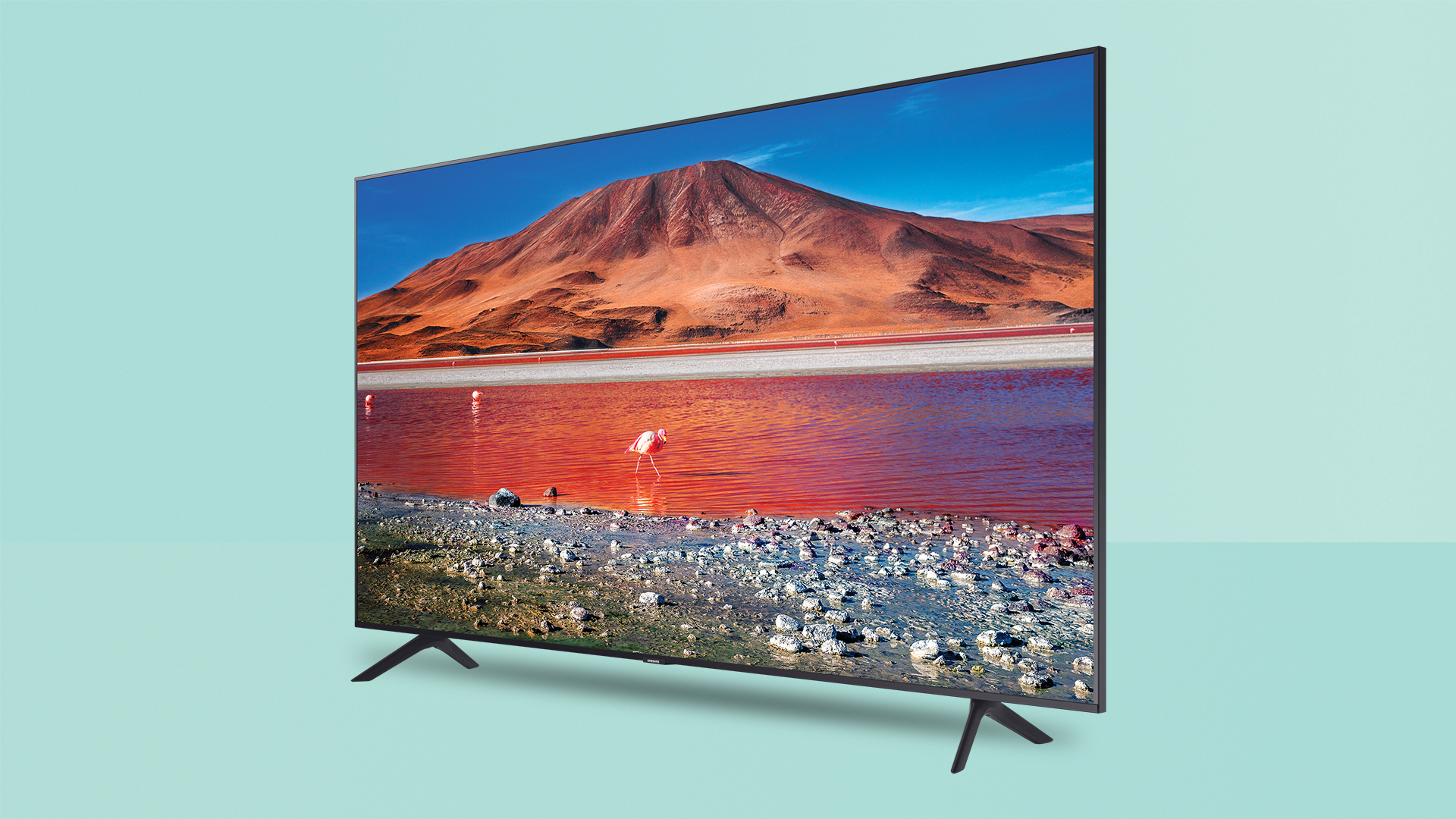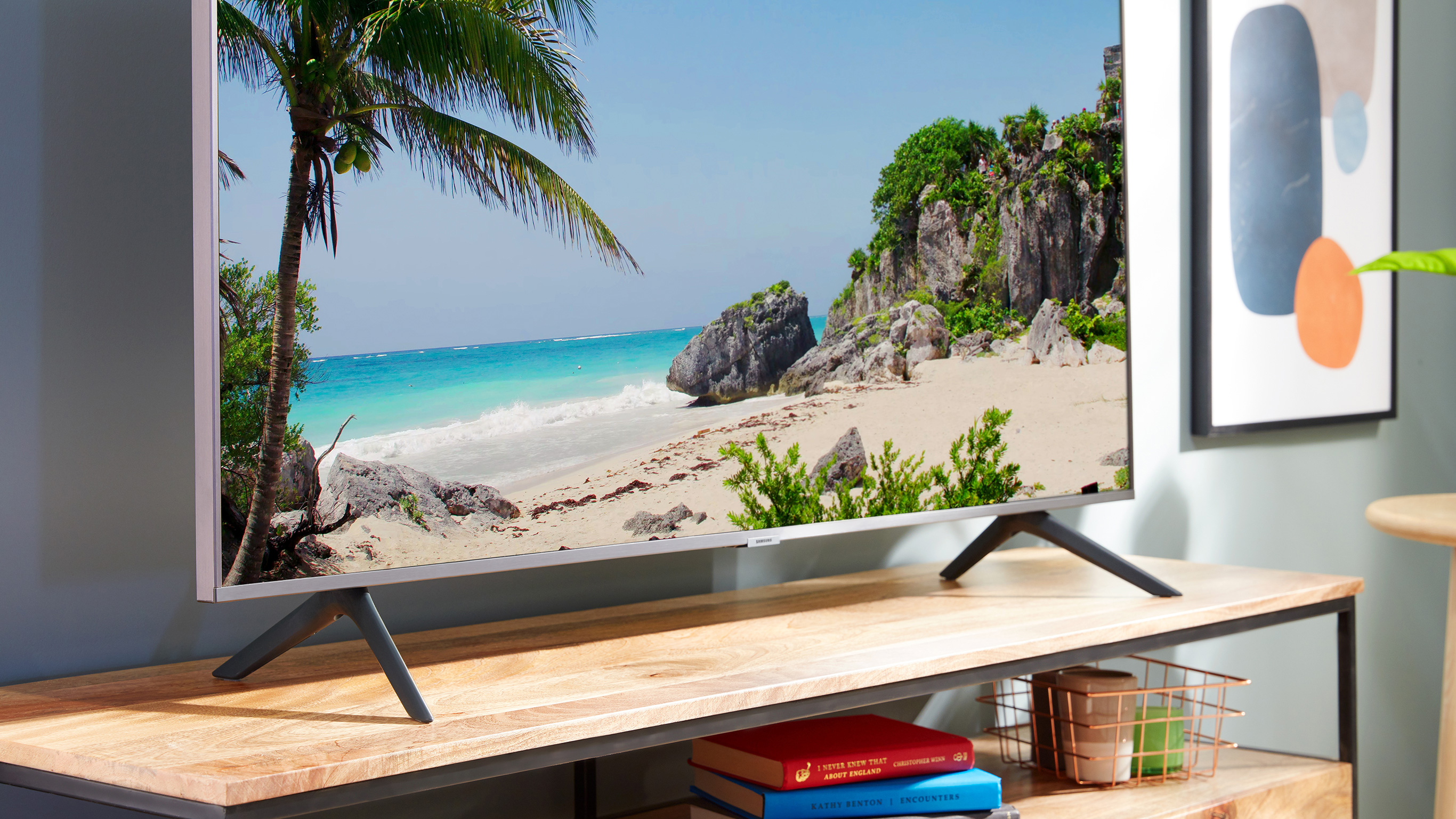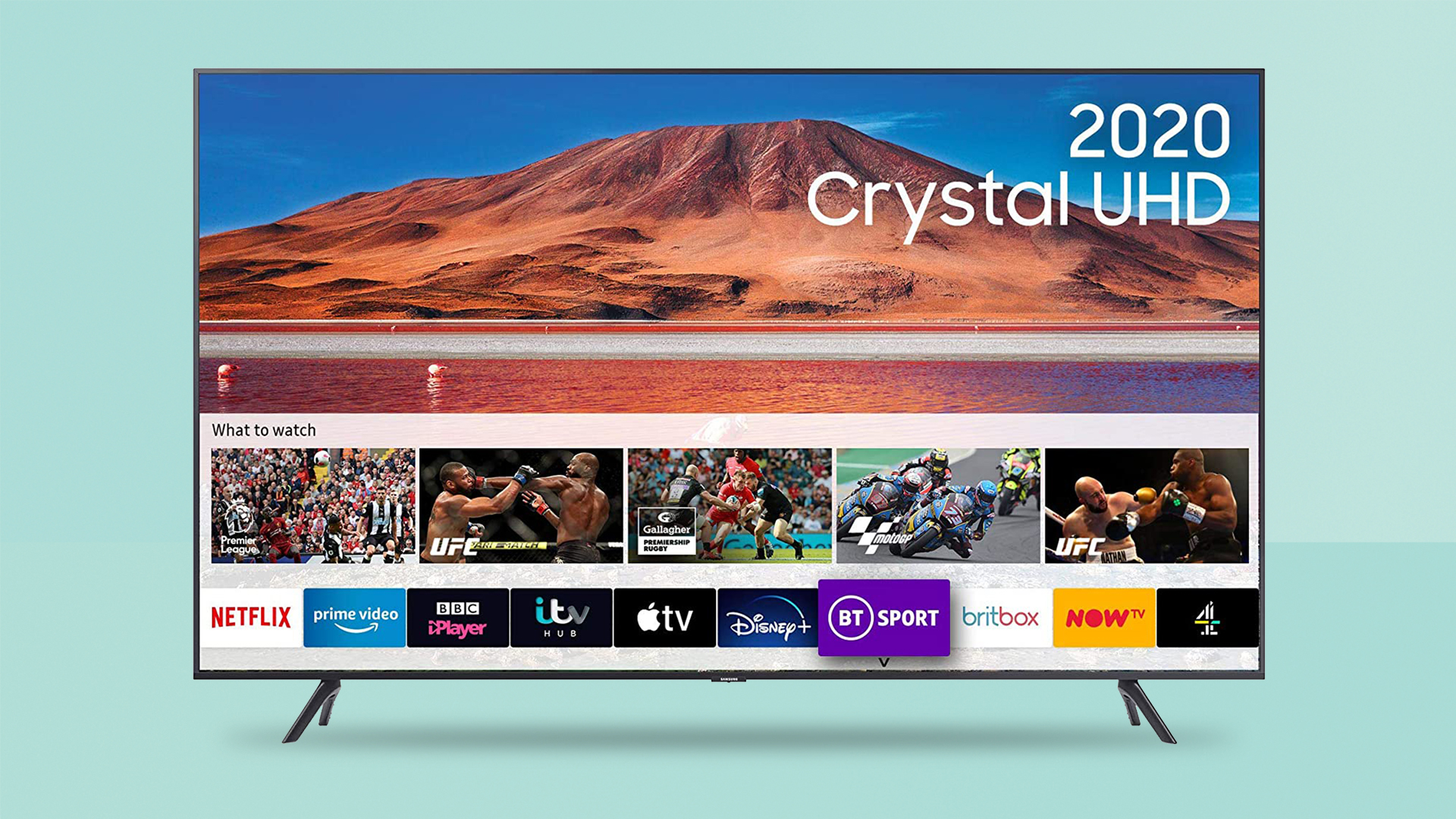Samsung TU7100/TU7000 (UE43TU7100) review: A cheap 4K TV that doesn't skimp on picture quality
The Samsung TU7100/TU7000 offers upscaling and colour quality far beyond the asking price, making it a perfect cheap smart TV


The Samsung TU7100 gives you an affordable 4K TV a great range of sizes, with picture quality and smart TV control that are beyond the asking price.
-
+
Unarguable price/performance ratio
-
+
Really good upscaling
-
+
Best-in-class user interface
-
-
Impoverished sound
-
-
Unpleasant remote control
-
-
No Dolby Vision
Why you can trust T3

This Samsung TU7100/TU7000 review is covering two models, because it's known as the TU7100 in the UK, or as the TU7000 in the US, and both in some countries (with just a colour difference on the frame separating the two). We've tested the UK's TU7100 model for this review.
On its 2020 release, the Samsung TU7100/TU7000 took its place firmly as one of the best ‘entry-level TVs by a very credible brand’, and is is easily one of the best TVs under £500, and at bigger sizes is one of the best TVs under £1000. And it's had no problem holding those positions, simply thanks to how strongly it punches above its weight. The biggest competitor right now is Samsung's own 2021 replacement models, which are only just appearing now.
Flagship TVs will only get you so far, and Samsung knows this as well as anyone –
they take their place in our list of of the best TVs but they never forget about the small guys, the less expensive and highly specced members of the family. This TV is made for people who aren't as interested in massive great technological tour de force TVs that cost as much as a decent second-hand car.
The TU7100/TU7000 is Samsung's latest demonstration of its understanding of mainstream customers. It starts from just 43 inches (which basically no flagship sets do) and starts from a relatively small price. Which, if Samsung continues to read the runes correctly, is exactly what a lot of people want.
It's the 43-inch set we're testing here, but there are bigger sets too – a lot of them, in fact, and all at excellent prices.
Samsung TU7100 review: Price & features
As is only right and proper for a TV that’s designed to appeal to as wide an audience as possible, the TU7100 is available in a range of sizes. The 43-inch model we're testing is the smallest, but there are also (deep breath) 50-inch, 55-inch, 58-inch, 65-inch, 70-inch and 75-inch models.
As we've mentioned, we're already seeing great discounts on all sizes of the TU7100 – here are the current best prices on all sizes:
Get all the latest news, reviews, deals and buying guides on gorgeous tech, home and active products from the T3 experts
(It might be worth noting at this point that you could buy one of each size of TU7100 and still only spend roughly a third of the cost of Samsung’s flagship 85Q950TS 8K monster. For more on that behemoth, you can check out our Samsung Q950TS review).
Despite its affordability, the UE43TU7100 is a pretty impressively specified device overall. It’s a 4K LED panel, and has a couple of HDMI inputs, a USB socket, a digital terrestrial TV tuner, and a CI card slot.
There’s integrated Wi-Fi along with an Ethernet socket, while Bluetooth and Apple AirPlay 2 compatibility completes the wireless offering. There’s a digital optical output, too, and one of the HDMI sockets is eARC enabled for use with even the most modern and well-specified of soundbars. The HDMI inputs support Auto Low Latency Mode (which will be helpful to next-gen console gamers), but no other specific PS5 and Xbox Series X new connectivity features, but that's okay – neither does anything else at this price.
HDR is also on board, from the HDR10+ dynamic format used by Amazon Prime Video, to the HLG variant used by broadcasters. There’s no sign of Dolby Vision HDR, which is a shame – it's starting to find its way into competing budget TVs. However, Samsung doesn't offer the tech on any of its TVs, so it's no surprise.
The UE43TU7100 is fitted with a couple of full-range drivers for audio, powered by a total of 20 watts.

Samsung TU7100 review: Picture quality
The UE43TU7100 is an unremarkable 60mm deep – and that’s most due to its backlighting, which is arranged around the edge of the rear of the panel. It’s a prosaic solution, one that’s entirely in keeping with the Samsung’s price, but it proves most effective.
The TU7100 demonstrates real dexterity where contrasts are concerned. It musters impressively deep black tones and equally admirable white tones. Blacks have decent lustre, but carry plenty of detail at the same time, and whites are clean and equally packed with information.
The Samsung puts proper distance between the two when the picture requires it, and controls its backlighting well enough that its edge-lit configuration really only betrays itself when watching some wide-screen 21:9 content, such as letterboxed movies. With black bars top and bottom, there’s just a hint of backlight bleed in each corner – but it’s barely noticeable, and hardly a deal-breaker.
This frankly unlikely level of fidelity is carried over to most other aspects of picture-making too – give the Samsung a fighting chance with some high-quality 4K content and it’s an eminently watchable TV. The colour palette it draws from is wide and convincing, and it has little trouble differentiating between even very subtle variations in tone, and serves up entirely believable skin-tones.
Quite often a TV that’s built down to a price betrays itself most obviously where skin-tones are concerned, but the TU7100 gives a poised, balanced account of complexions.
Detail levels are respectably high throughout, which only adds to the impression of realism where skin-tones are concerned, and picture noise stays low even in the most complex scenes. Movement, too, is dealt with intelligently, with the Samsung gripping even rapid or unpredictable motion well. Edges can shimmer a little during the most testing scenes, it’s true, but on the whole the TU7100 is an organised and confident performer.
Stepping down in quality to some 1080p Full HD content actually confirms the Samsung as a fully capable device. Naturally enough there’s a drop-off in detail levels, accompanied by a little less certainty where motion is concerned and a little more picture noise (especially in scenes of uniform colour, such as sports broadcasts), but the TU7100 proves an adept upscaler. Some softness in an upscaled picture is only to be expected, but the Samsung stays pretty regimented in most circumstances.
Of course, ‘most circumstances’ can’t reasonably be expected to include elderly daytime TV broadcasts that predate both high-definition and the 16:9 aspect ratio. And, sure enough, televised reruns of 1980s drama series managed to look simultaneously soft and noisy, ill-defined and coarse. But really, did you imagine it would be any other way?

Samsung TU7100 review: Sound quality
Unsurprisingly, the Samsung’s audio performance is rather more in keeping with its bargain price than its picture quality. There may be 20 watts of power available, but they sound rather wheezy and weedy watts – even with the volume wound a long way northwards, the TU7100 struggles to make much of an impression. And anyway, the louder you play, the thinner and harder the Samsung sounds.
There’s decent midrange detail on offer, it’s true, and that helps intelligibility of broadcasts no end, particularly around speech. But as far as dynamics or meaningful low-end presence are concerned, they’re conspicuous only by their absence.
A soundbar will make a really big difference here, even if it's at the budget end of things. We'd especially recommend one if you're looking at the bigger screen sizes, because a big-scale picture and small-scale sound is just a shame.

Samsung TU7100 review: Design & usability
‘Design’ isn’t really something that happens to entry-level TVs, and sure enough the Samsung UE43TU7100 isn’t so much ‘designed’ as ‘assembled’.
Having said that, though, this screen does at least look neat and tidy. It doesn’t have too much by way of bezel, its simple push-and-click ‘boomerang’ feet are discreet, and the rear panel is nicely curved. Those feet are quite a long way apart, though, so if your new Samsung is going to stand on a surface rather than be hung on the wall you’d better make sure there’s sufficient width for it to do so.
Control is available via a small, overbuttoned and altogether too complicated remote handset. This might be the single biggest indicator of where the TU7100 sits in the Samsung hierarchy, which is a pity, because you’ll probably be using it quite a lot. The desire to include every single function on quite a small handset means too many of the buttons are too small, and their labelling is smaller still.
There’s no integrated voice control, but if the TU7100 is on the same network as mic-equipped Amazon Alexa or Google Assistant-enabled smart speakers, a degree of voice control is available that way.
Regardless of how you choose to control the Samsung, though, you’ll have access to one of the more agreeable and comprehensive user interfaces around. The Tizen-based Smart Hub operating system is clean and logical – it’s a little sluggish here when compared to equivalents from higher up the Samsung model range (which is probably due to its less powerful processor), but it makes up for that by being an authentic pleasure to use.
Every catch-up TV service is included, and its streaming app selection is extensive too – Apple TV and Disney+ are available alongside the more usual Netflix, Amazon Prime Video, Rakuten and so on.

Samsung TU7100 review: Verdict
‘You get what you pay for’ is a truism as old as capitalism itself, but in the case of the Samsung UE43TU7100 your money buys a little more than you might be expecting.
For this price, it’s capable of truly commendable picture quality – basically the best we've seen. We can forgive its tissue-paper-and-comb audio system, its slightly lethargic interface response times and its lack of a third HDMI input (though this is probably the biggest caveat). It still remains our pick as the top TV at this price.
Even here in 2021, discounts mean that the TU7100/TU7000 is still an excellent buy. Its biggest competitor is its own replacement, the Samsung AU7100, and we'd say which you choose out of those two may well just come down to the price you'd like to pay.
Samsung TU7100 review: Also consider
In the UK, readers should take a look at the Hisense Roku TV B7120, which is a similarly low-price set with excellent smart TV platform and impressive picture quality.
In the US, check out TCL's Class 5 Roku TVs, which bring QLED's rich HDR colours at an incredibly low price, again with Roku's excellent smart TV platform. However, those sets only start from 50 inches – for 43 inches, you'll need to look to the Class 4 TVs, which still have Roku, but no QLED.
And in both cases, the Samsung AU7100 should absolutely be on your radar. If you can step up the budget at all, take a look at our Samsung AU9000 review too – this is Samsung's best TV from 2021 that isn't a QLED, so it balances budget and price really well.
Also, the cheapest QLED model from 2021 is now much cheaper than you might expect – more price cuts mean that the Samsung Q60T is one of the bargains of the year. Here's our full Samsung Q60T review.
Simon Lucas is a freelance technology journalist and consultant, with particular emphasis on the audio/video aspects of home entertainment. Before embracing the carefree life of the freelancer, he was editor of What Hi-Fi? magazine and website – since then, he's written for titles such as Wired, Metro, the Guardian and Stuff, among many others. Should he find himself with a spare moment, Simon likes nothing more than publishing and then quickly deleting tweets about the state of the nation (in general), the state of Aston Villa (in particular) and the state of his partner's cat.
